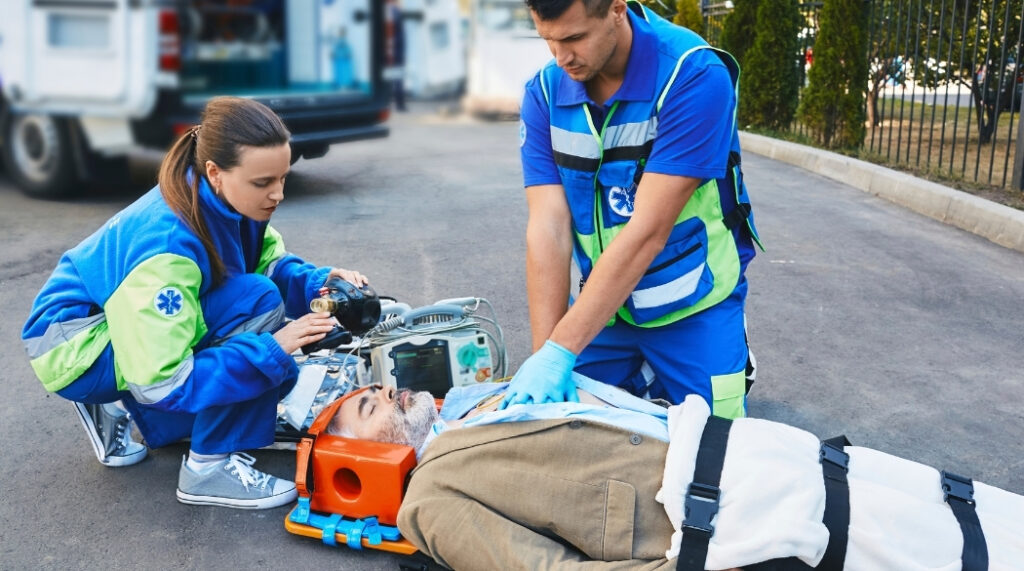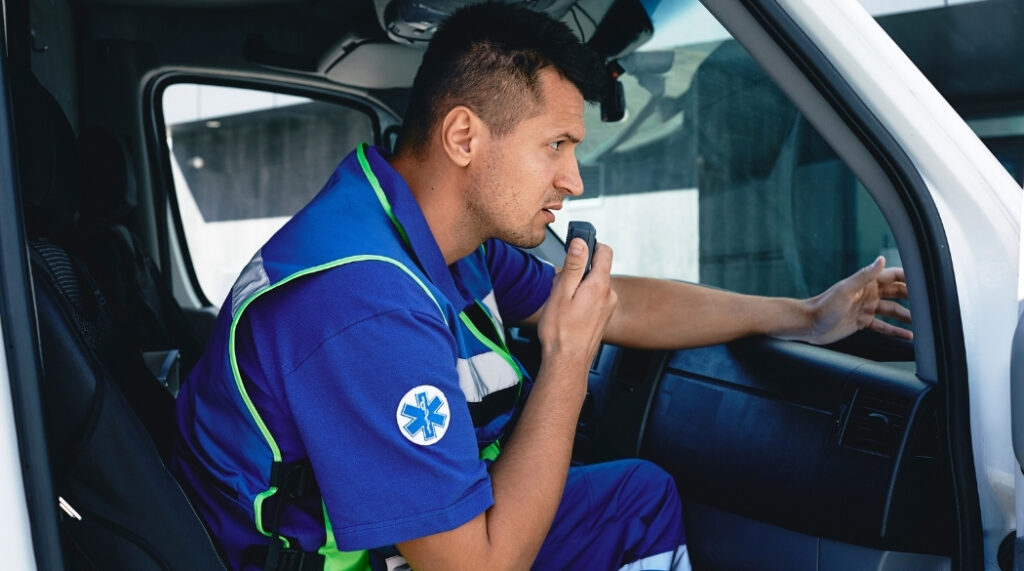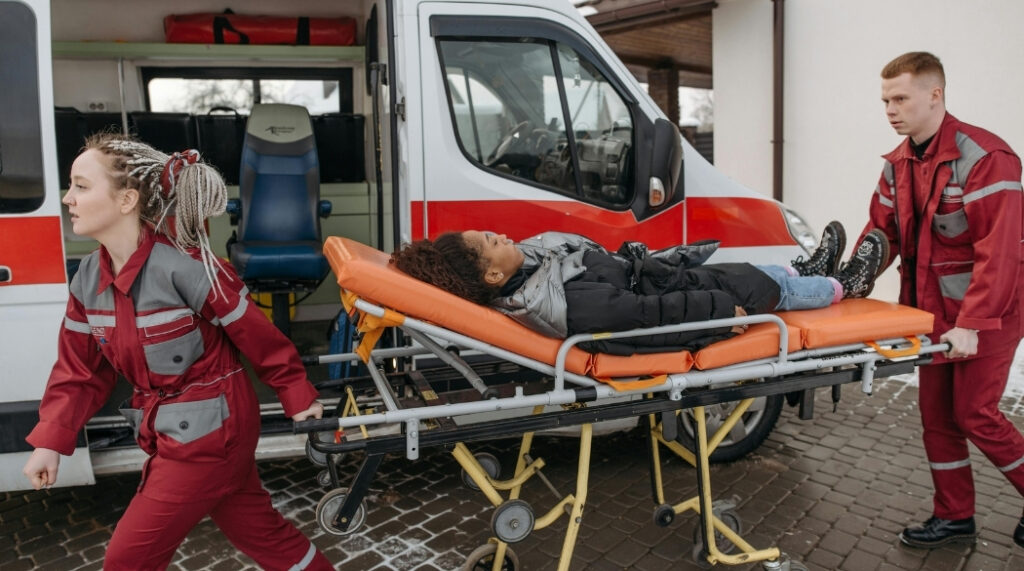In times of crisis, when seconds can mean the difference between life and death, Emergency Medical Technicians (EMTs) are the unsung heroes on the frontline. They are often the first medical professionals to arrive at the scene of accidents, natural disasters, and sudden health emergencies. With unmatched courage and speed, EMTs administer critical care, stabilise patients, and transport them safely to medical facilities.
Choosing a career as an Emergency Medical Technician is more than just a job—it’s a calling. It requires mental strength, emotional intelligence, physical stamina, and expert-level training in First Aid, trauma care, and emergency protocols. This powerful career also provides stability, advancement opportunities, and the satisfaction of saving lives every single day.
Whether you’re looking to enter the healthcare field or seeking a new path filled with purpose, this guide will take you through everything you need to know about becoming an EMT—from qualifications and career pathways to real-world responsibilities, earnings, and how it connects to becoming a Paramedic.
What Does an Emergency Medical Technician Do?
An Emergency Medical Technician (EMT) is a specially trained professional who provides emergency medical assistance in pre-hospital settings. They are typically dispatched through emergency response systems (like 999 or 911) and arrive at scenes where immediate care is needed. This could be due to a traffic accident, cardiac arrest, overdose, or any other life-threatening event.
EMTs assess patients, perform essential medical procedures such as CPR or bleeding control, administer oxygen, and transport individuals to medical facilities while continuing treatment en route. Their actions are guided by established medical protocols, and they must make swift decisions under pressure.
Unlike hospital-based staff, EMTs work in unpredictable environments—on roadsides, in homes, at public events, or disaster zones. Their equipment is mobile, and their team often includes a driver or another medical responder such as a Paramedic.
EMT vs. Paramedic: What’s the Difference?
Although people often confuse the two, there is a significant distinction between an EMT and a Paramedic, particularly in training depth, clinical skills, and scope of responsibilities.
| Role | Training Duration | Skills & Scope | Common Settings |
|---|---|---|---|
| EMT | 6 months to 1 year | Basic Life Support (BLS), First Aid, oxygen therapy | Ambulances, events, emergencies |
| Paramedic | 1.5 to 3 years (Diploma/Degree) | Advanced Life Support (ALS), IV medication, ECG use | Trauma units, air ambulances, ICUs |
An EMT is trained to manage common emergencies with non-invasive procedures, while Paramedics are trained for more advanced interventions such as drug administration, airway management, and cardiac support. Many EMTs choose to advance their careers by becoming Paramedics, creating a natural upward trajectory.

Key Responsibilities of an EMT
An EMT’s role is diverse and requires a balance between technical expertise, physical agility, and emotional resilience. These professionals are not only lifesavers but also compassionate listeners and effective communicators.
Typical responsibilities include:
- Assessing patient conditions quickly and accurately
- Performing life-saving First Aid such as CPR, wound treatment, and bleeding control
- Stabilising broken bones or immobilising spinal injuries
- Using oxygen delivery equipment and automated defibrillators
- Monitoring vital signs and patient responses
- Transporting patients safely to healthcare facilities
- Reporting patient conditions and treatments to hospital staff
- Keeping medical supplies stocked and equipment functional
Every day presents new challenges. No two emergency calls are ever the same, which makes the job both mentally stimulating and deeply meaningful.
Qualifications and Training Requirements
Becoming an Emergency Medical Technician requires specialised training, a commitment to health and safety, and hands-on clinical experience. While the specifics may vary depending on your country or region, the general pathway includes foundational education, medical coursework, practical training, and certification exams.
General Qualification Requirements
- Minimum age requirement (typically 18 years old)
- High school diploma or equivalent
- Clean background check
- Physically fit and able to lift/carry equipment or patients
- Strong grasp of written and spoken English
EMT Training Components
- First Aid and Basic Life Support (BLS) – Learning to handle trauma, CPR, and choking incidents.
- Emergency Procedures and Medical Terminology – Understanding ambulance protocols and terminology used in emergencies.
- Patient Assessment Skills – Evaluating patients, recording symptoms, and observing responses.
- Field Experience – Supervised training in ambulances and emergency departments.
- Written and Practical Exams – Certification typically includes a written multiple-choice exam and hands-on assessment.
After becoming certified, most EMTs are also required to complete CPD (Continuing Professional Development) or refresher training periodically to stay updated with current standards and emergency technologies.
Roadmap to a Career in Emergency Medical Services
The journey to becoming an EMT can start as early as high school. Those interested in the medical field or public service often begin by volunteering for community response teams or taking introductory First Aid courses. Others transition into emergency medicine after military service, police work, or roles in healthcare.
The typical roadmap looks like this:
- Complete a foundational education – Focus on biology, health, and science courses.
- Undertake EMT training – Choose an accredited program or vocational college.
- Pass certification exams – Often regulated by national bodies or health departments.
- Apply for EMT roles – Join public ambulance services, private response teams, or event medical providers.
- Gain field experience – Develop confidence and deepen clinical knowledge.
- Pursue advanced qualifications – Move toward becoming a Paramedic or emergency supervisor.
For those with ambitions beyond the ambulance, this career can also lead to roles in emergency planning, air ambulance crews, disaster response units, or even international humanitarian relief.
Salary Expectations and Career Progression
A career as an EMT offers not only personal fulfilment but also stable employment and growth opportunities. Salaries can vary depending on experience, geographic location, and whether you work in the public or private sector.
| Role | UK Average Salary (2025 Estimate) | Additional Notes |
|---|---|---|
| Entry-Level EMT | £21,000 – £26,000 per year | Initial training completed, basic First Aid certified |
| Experienced EMT | £27,000 – £32,000 per year | 2–4 years experience, working independently |
| Advanced EMT / Supervisor | £33,000 – £38,000+ per year | Leadership roles, oversees teams |
| Paramedic | £35,000 – £50,000+ per year | Advanced Life Support certified, eligible for more duties |
In addition to salary, many EMTs receive overtime pay, shift differentials, pensions, and healthcare benefits. Some employers also offer tuition reimbursement for those pursuing Paramedic-level certifications or degrees.
Workplace Environments and Schedules
EMTs primarily work in ambulance services, either for the NHS or private companies. However, their skills are also valuable in other environments:
- Hospitals and urgent care centres
- Outdoor events and festivals
- Construction and industrial sites (as on-site medics)
- Film and TV production sets
- Offshore oil platforms and ships
- International humanitarian organisations
Working hours can be irregular, as emergencies happen around the clock. Shifts may include nights, weekends, and holidays, often rotating to ensure full coverage. EMTs must be comfortable working under pressure, in all weather conditions, and occasionally in dangerous or distressing environments.
Despite the intensity, the profession is deeply rewarding. EMTs consistently report high job satisfaction due to the direct impact they have on saving lives and supporting communities.
Equipment and Technology EMTs Use
EMTs rely on a variety of medical tools and communication devices to deliver efficient emergency care. Mastery of this equipment is part of their training and crucial to performance in the field.
Commonly used tools include:
- Defibrillators (AEDs)
- Oxygen tanks and masks
- Trauma kits and splints
- Glucometers
- Emergency suction units
- Radios and GPS systems
- First Aid kits and airway management devices
Many EMTs also use digital tablets or mobile apps to record patient details, manage reports, and communicate with hospital teams in real time.

Soft Skills for EMT Success
While technical skills are essential, being a great Emergency Medical Technician also requires a strong set of soft skills:
- Compassion – Offering emotional support to patients and families.
- Communication – Explaining procedures clearly to patients and collaborating with team members.
- Calmness Under Pressure – Managing stress during traumatic incidents.
- Problem Solving – Making critical decisions when time is limited.
- Attention to Detail – Noticing changes in vital signs or patient behaviour.
These traits help EMTs perform their duties effectively and ensure they remain grounded despite the challenging nature of their work.
Continuing Education and Career Advancement
For many EMTs, initial training is just the beginning. There are various pathways for professional development:
- Advance to Paramedic – This involves further study (often a diploma or foundation degree), deeper clinical skills, and increased responsibilities.
- Specialised Certifications – Such as Emergency Driving, Tactical First Aid, or Pediatric Emergency Care.
- Management and Leadership – Leading EMT teams, scheduling shifts, or overseeing operations.
- Instruction and Education – Becoming a certified EMT trainer or instructor for future cohorts.
- Cross-Training – Adding qualifications in firefighting, disaster response, or search and rescue.
Many professionals also complement their EMT training with mental health first aid, safeguarding, and trauma counselling skills—especially useful in today’s complex emergency scenarios.
Why Choose a Career as an Emergency Medical Technician?
There are countless reasons why people choose to become EMTs. Some are inspired by personal experiences, others seek a meaningful career that goes beyond the 9-to-5. Whatever the motivation, EMTs share a common drive to serve and protect.
This role offers:
- A strong sense of purpose and service
- High employability across multiple sectors
- Opportunities to grow into a Paramedic or other health roles
- Flexibility to work in a variety of environments
- Exposure to medical and crisis management experience
In a world that will always need heroes, the Emergency Medical Technician stands out as a professional who combines heart, skill, and bravery in every shift.
Final Thoughts
Becoming an Emergency Medical Technician is not just a career—it’s a commitment to making a real difference in people’s lives. Whether you’re stabilising a patient at the scene of a car crash or delivering life-saving First Aid at a public event, EMTs are vital pillars of any healthcare system.
If you’re passionate about helping others, thrive under pressure, and want to build a career that blends physical action with critical thinking, becoming an EMT could be your perfect path. With further study, you could even transition into a Paramedic role, expanding your scope and earning potential.
There’s never been a better time to enter this field. With high demand, clear progression, and the unmatched reward of saving lives, a future as an EMT promises a career that’s both powerful and profound.

